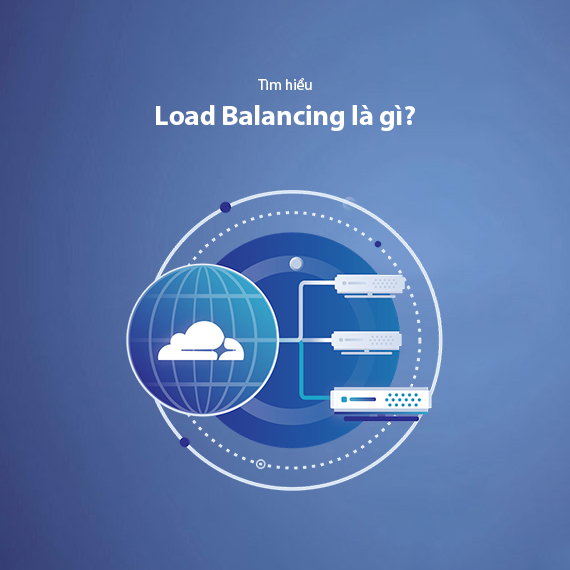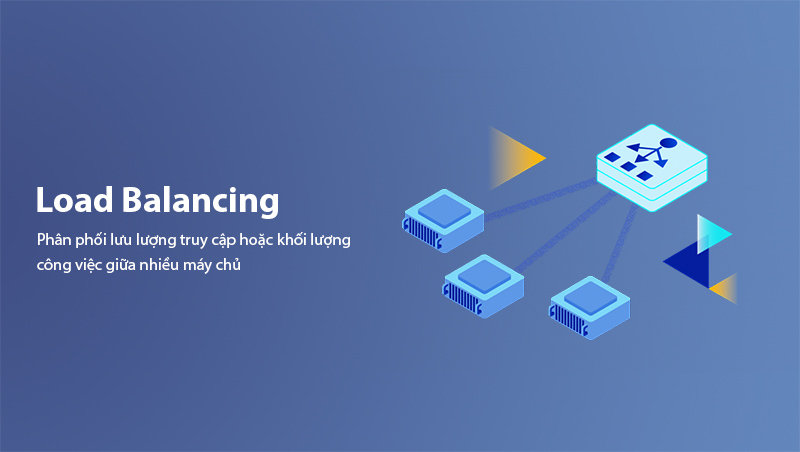Understanding What Load Balancing Is – Principles, Benefits, and Applications
- Published on

- What is Load Balancing?
- Role of Load Balancing in Network Infrastructure
- Benefits of Load Balancing
- How Load Balancing Works
- Load Balancing Algorithms
- Hardware Load Balancing vs. Software Load Balancing
- Hardware Load Balancing
- Software Load Balancing
- Real-world Applications of Load Balancing
- E-commerce Systems
- Streaming and Online Entertainment Services
- Cloud Computing Infrastructure
- Microservices Applications
- Banking and Financial Systems
- Key Considerations When Implementing Load Balancing
- Choose the Right Load Balancer Type
- Consider Load Balancing Algorithms
- Set Up Health Checks
- Ensure Security
- Monitor and Optimize Performance
- Check Scalability
- Conclusion
What is Load Balancing?
Load Balancing is a technique in the field of network infrastructure used to distribute traffic or workloads across multiple servers in a system. Instead of directing all traffic to a single server, a Load Balancer acts as a “referee,” directing user requests to different servers, ensuring that resources are used in an efficient and balanced way. This helps reduce the risk of server overload, improve response time, and ensure that services remain stable even in the event of failure on one or more servers.

Real-life example: Imagine visiting a large e-commerce site during a holiday sale when there is a sudden spike in traffic. Thanks to the Load Balancer, you can still experience smooth shopping instead of encountering website overload.
With the rapid development of distributed systems and cloud computing, Load Balancing has increasingly become a core component in ensuring performance and high availability for online applications and services.
Role of Load Balancing in Network Infrastructure
Load Balancing plays a crucial role in maintaining the performance and stability of modern network systems. By evenly distributing traffic across multiple servers, it helps minimize the risk of overload and improves response times for users. In particular, for environments handling large workloads such as web applications, e-commerce services, or databases, implementing Load Balancing is an essential solution to ensure continuous operation of the system.
A major benefit of Load Balancing is its ability to provide failover. When a server experiences a failure or interruption, the Load Balancer automatically redirects traffic to other operational servers. This ensures high availability, preventing users from encountering errors when accessing services. Additionally, Load Balancing allows businesses to easily scale their infrastructure (scalability) without disrupting system operations.
Thanks to its critical role in ensuring operational efficiency, Load Balancing is widely applied in systems such as cloud computing, microservices, and large-scale online services.
Benefits of Load Balancing
Implementing Load Balancing brings numerous significant benefits, especially as online systems increasingly require stability and the ability to handle high traffic. Some of the main benefits include:
-
Increased system performance: The Load Balancer ensures no server in the system becomes overloaded, optimizing processing speed and improving the user experience. Traffic is evenly distributed across servers, minimizing response time and avoiding network congestion.
-
High availability: Thanks to its ability to redirect traffic when a server fails, Load Balancing helps maintain continuous operation of the system, preventing service disruptions.
-
Scalability: Load Balancing supports easy system scaling by adding new servers to the cluster. This is particularly useful when businesses face sudden spikes in traffic during large campaigns.
-
Enhanced security: Some modern Load Balancers integrate features such as blocking malicious traffic, DDoS attack detection, and data encryption, helping protect the system from external threats.
With these benefits, Load Balancing is not just a technical tool but also a strategic approach to building a robust, flexible, and sustainable infrastructure for businesses.
How Load Balancing Works
The operation of Load Balancing relies on intelligently receiving and distributing traffic from users to servers in the system. When a request is sent, the Load Balancer decides which server is best suited to process it based on the current status of the system. This decision is often based on factors such as: server load, active connections, or even network latency.
The basic steps involved in Load Balancer operation include:
- Receiving the request: The Load Balancer receives all user requests before forwarding them to the server.
- Analyzing server status: The Load Balancer continuously checks the status of servers in the cluster to ensure that only operational servers receive requests.
- Forwarding the request: After analysis, the Load Balancer routes the request to the optimal server to ensure performance and processing speed.
- Responding to the user: The selected server processes the request and returns the result through the Load Balancer.
Real-life example: In a large e-commerce system, when you make a purchase, every request like searching for products or processing payments is routed by the Load Balancer to ensure smooth operation without you noticing its intervention.
Modern Load Balancers not only distribute traffic but also offer features such as health checks, priority-based distribution, and even data encryption to enhance security. This ensures that the system operates smoothly even under sudden spikes in workload.
Load Balancing Algorithms
To efficiently distribute traffic, Load Balancers use various algorithms, each designed to meet specific system requirements. Below are some of the most popular algorithms:
-
Round Robin: This is the simplest algorithm, where requests are distributed sequentially to each server in a loop. Each server processes a request in turn, ensuring that no server is skipped. This method works well for systems with servers that have similar configurations.
-
Least Connections: This algorithm prioritizes sending requests to the server with the fewest active connections, ensuring load is evenly distributed based on the actual state of the server. This method is effective for systems where request processing times are not uniform.
-
IP Hash: Requests are distributed based on the user’s IP address, ensuring each user is routed to the same server throughout their session. This algorithm is ideal for applications that require session persistence.
-
Weighted Round Robin: An advanced variant of Round Robin, this algorithm assigns a weight to each server based on its processing capacity. Stronger servers will handle more requests, ensuring optimal resource utilization.
-
Random: Requests are distributed randomly among servers. This method is simple but works best in smaller systems with similar server configurations.
Note: The choice of Load Balancing algorithm should be based on the specific characteristics of the system and workload. For example, in large e-commerce applications, Weighted Round Robin or Least Connections are often preferred to ensure optimal performance.
By using intelligent algorithms, Load Balancers not only optimize performance but also ensure flexibility in handling complex scenarios such as uneven workloads or user session requirements.
Hardware Load Balancing vs. Software Load Balancing
Load Balancing can be implemented through two main forms: hardware load balancing and software load balancing. Each type has its own advantages and disadvantages, suited for different needs in network infrastructure.
Hardware Load Balancing
This solution uses specialized hardware devices like F5 Big-IP, Citrix ADC, or Barracuda Load Balancer. These devices are designed to handle network traffic at high speeds and integrate many security features such as DDoS attack detection and SSL encryption.
-
Advantages:
- High performance, handling millions of requests per second.
- High reliability with failover and integrated security features.
- Suitable for large organizations and systems that require maximum stability.
-
Disadvantages:
- High upfront investment costs.
- Difficult to scale during sudden increases in demand without upgrading equipment.
Software Load Balancing
This solution uses software applications or services like HAProxy, NGINX, or Traefik to perform the load balancing function. The software can be deployed on regular servers or in a cloud environment.
-
Advantages:
- Lower cost, especially when using open-source solutions.
- Flexible, easy to configure, and integrates well with modern tools like Docker or Kubernetes.
- Easily scalable and customizable based on needs.
-
Disadvantages:
- Performance depends on the hardware resources of the server.
- Requires high technical expertise for management and optimization.
Which option is suitable?
If you are operating a large system with very high traffic and need to ensure maximum availability, hardware load balancing is the optimal solution. On the other hand, for medium and small businesses or environments requiring high flexibility, software load balancing is a more cost-effective and efficient choice.
Understanding this difference helps organizations make the right decision, optimizing costs while ensuring system performance.
Real-world Applications of Load Balancing
Load Balancing is not just a technical solution but also a key factor in the efficient operation of IT systems. Here are some prominent real-world applications of Load Balancing:
E-commerce Systems
In large e-commerce websites like Amazon, Shopee, or Tiki, traffic often spikes during discount events or holiday seasons. A Load Balancer helps distribute the traffic evenly across servers, ensuring a smooth shopping experience without the website crashing.
Streaming and Online Entertainment Services
Platforms like Netflix, YouTube, and Spotify use Load Balancing to deliver content to millions of users globally. With enormous traffic from different regions, the Load Balancer routes traffic to the nearest servers to reduce latency and improve service quality.
Cloud Computing Infrastructure
In the cloud environments of providers like AWS, Google Cloud, or Microsoft Azure, Load Balancing plays a crucial role in automatically distributing resources, scaling the system, and managing workloads intelligently.
Microservices Applications
For systems using a microservices architecture, Load Balancing helps coordinate traffic between small services. This is especially important to maintain the performance and scalability of the system.
Banking and Financial Systems
In the banking sector, online transaction applications need to ensure continuous and secure operations. Load Balancing helps process a large number of transactions and enhances security by integrating DDoS attack prevention mechanisms.
You can check out the article What is Nginx? to learn how web servers like Nginx support Load Balancing in large systems.
Thanks to these diverse applications, Load Balancing has become an essential part of building flexible, stable, and efficient systems, helping businesses maintain a competitive edge in the digital era.
Key Considerations When Implementing Load Balancing
Although Load Balancing offers numerous advantages, implementing this solution requires careful consideration to ensure effectiveness and alignment with system requirements. Here are some important points to keep in mind:
Choose the Right Load Balancer Type
Depending on the needs, you can choose between hardware load balancing and software load balancing. For large enterprises that require high performance and stability, dedicated hardware devices are ideal. On the other hand, software Load Balancers are more suitable for flexible, cost-effective systems.
Consider Load Balancing Algorithms
Choosing the right Load Balancing algorithm (such as Round Robin, Least Connections, or Weighted Round Robin) greatly impacts system performance. Base your decision on the characteristics of the application, traffic volume, and processing requirements.
Set Up Health Checks
To ensure that requests are only distributed to servers that are functioning properly, you need to configure the Health Check feature. The Load Balancer will periodically check the status of servers and remove any unavailable ones from the distribution list.
Ensure Security
During implementation, integrate security measures such as SSL/TLS certificates, firewalls, and DDoS attack prevention mechanisms to protect the system from potential threats.
Monitor and Optimize Performance
After deployment, monitoring the performance of the Load Balancer and related servers is crucial. Use network monitoring tools or integrate monitoring services to detect and resolve issues promptly.
If you are using cloud services like AWS or Google Cloud, explore the built-in Load Balancing features to maximize resource utilization and reduce configuration efforts.
Check Scalability
Ensure that the system can easily scale when traffic increases. Prioritize solutions that support autoscaling to automatically add servers when needed.
By paying attention to these factors, you can implement Load Balancing optimally, ensuring stable operation and maximum performance to meet long-term growth demands.
Conclusion
Load Balancing is a vital component in building modern network infrastructure systems, enhancing performance, availability, and security for online services. Through intelligent and efficient traffic distribution, a Load Balancer ensures that the system operates stably while supporting flexible scalability in an ever-evolving technological environment.
Implementing Load Balancing requires careful consideration of factors such as Load Balancer type, distribution algorithms, security requirements, and system scalability. For businesses, understanding the real-world applications of Load Balancing in areas like e-commerce, cloud computing, and streaming will help optimize technology decisions and deliver the best user experience.
With the tremendous benefits Load Balancing brings, incorporating this technology into your system is a crucial step to ensure continuity, efficiency, and scalability for the future.
Latest Posts

Lesson 26. How to Use break, continue, and return in Java | Learn Java Basics
A guide on how to use break, continue, and return statements in Java to control loops and program execution flow effectively.

Lesson 25. The do-while Loop in Java | Learn Basic Java
A detailed guide on the do-while loop in Java, including syntax, usage, examples, and comparison with the while loop.

Lesson 24. How to Convert Decimal to Binary in Java | Learn Basic Java
A guide on how to convert numbers from the decimal system to the binary system in Java using different methods, with illustrative examples.

Lesson 23. How to Use the While Loop in Java | Learn Java Basics
Learn how to use the while loop in Java with syntax, real-world examples, and practical applications in Java programming.
Related Posts

What is .htaccess? Guide to Editing and Configuring .htaccess
Learn about the .htaccess file, its functions, and how to edit and configure .htaccess to optimize security, SEO, and website performance.

What is DNS? The Mechanism of Domain Name Resolution System
Learn about DNS, the mechanism of the domain name resolution system, and the important role of DNS in maintaining website operations.

What is a Dedicated Server? A Guide to Choosing the Right Dedicated Server
Learn about Dedicated Servers, the benefits of using a dedicated server, and how to choose the right one for your needs.

Difference Between Web Server and Application Server
Learn the difference between Web Server and Application Server – two essential servers in web technology systems. Explore their structure, functions, how they work, and when to use each type of server.

